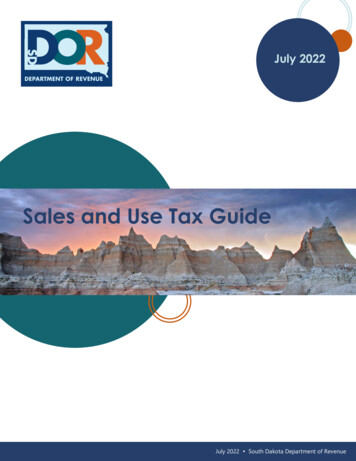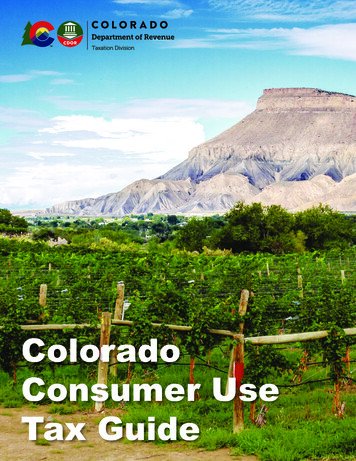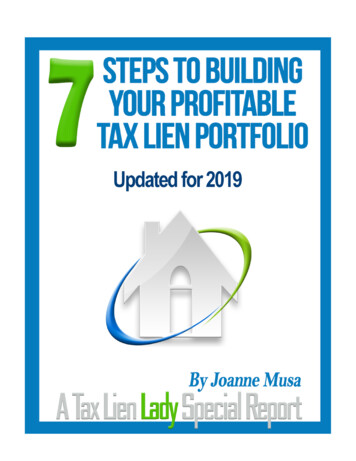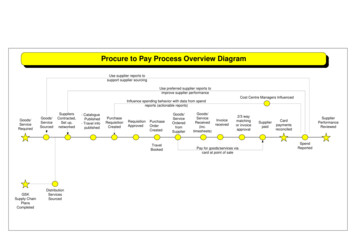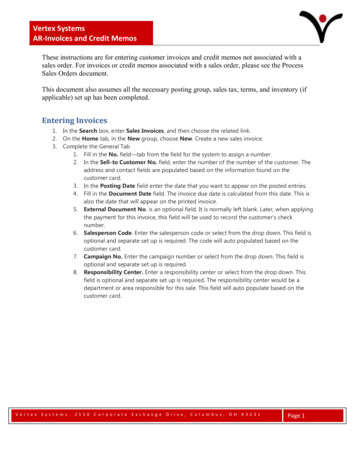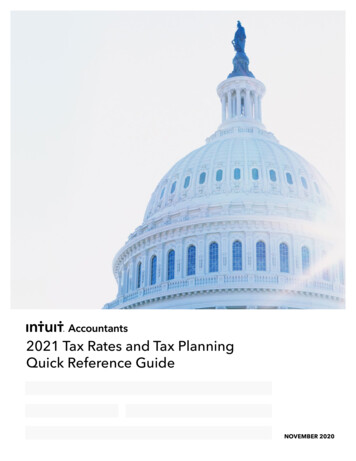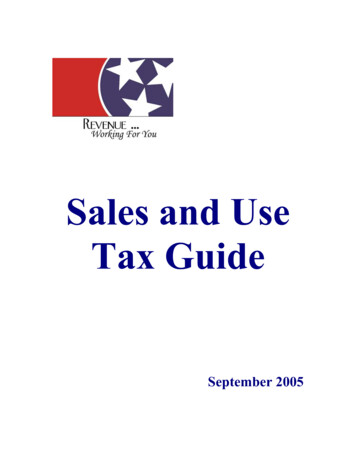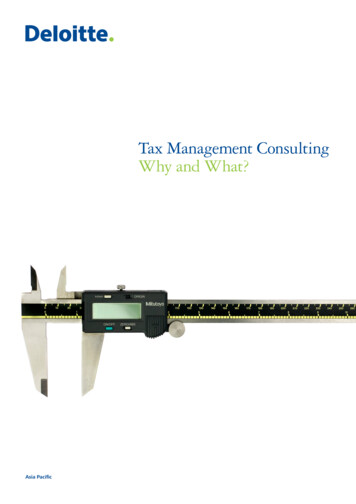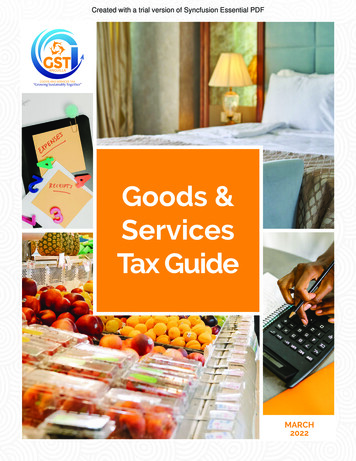
Transcription
Created with a trial version of Syncfusion Essential PDFGoods &ServicesTax GuideMARCH2022
DISCLAIMERThese notes are for guidance only. They reflect the law and the tax position at thetime of publication. They do not replace the legislation or affect your right to objectand appeal.If in doubt, you should consult the Inland Revenue Department.You may find the following documents useful for further explanation on specificissues:GST Act 2021GST Regulations 2022Specific Sector Guides
TABLE OF CONTENTS1.0 INTRODUCTION42.0 GOODS AND SERVICES TAX (GST)53.0 TAXABLE ACTIVITIES AND SUPPLIES84.0 PRICING FOR GST155.0 INPUT AND OUTPUT TAX186.0 KEEPING PROPER BOOKS ANDRECORDS227.0 ISSUING SOURCE DOCUMENTS258.0 RETURNS AND REFUNDS FOR GST299.0 IMPORTS AND EXPORTS3110.0 TRANSITIONAL ARRANGEMENTS3511.0 MODEL DOCUMENTATION39
1.0 INTRODUCTIONThe Goods and Services Tax (“GST”) Guide aims toprovide a general understanding of how GST works.This guide should be read in conjunction with the Goodsand Services Tax Act 2021 (“GST Act”) and the Goods andServices Tax Regulations 2022 (“GST Regulations”).Inland Revenue Department GST Guide4
2.0 GOODS AND SERVICES TAX (GST)2.1 GST MechanismMost goods and services imported into or supplied in Anguilla arecharged GST. The GST charged and collected by registered businessesis referred to as output tax. A business also pays GST on goods andservices it buys from its suppliers or imports into Anguilla. This isreferred to as input tax.GST registered businesses will offset the input tax against the outputtax. The difference between output tax and input tax is remitted tothe Comptroller.GST is ultimately paid by the consumer but collected by governmenton the profit (the value-added) at each stage in the supply chain asdepicted in the figure below.GSTcharged onsalesOutput Tax-GSTpaid onpurchases GSTpayableor excesscreditInput TaxFigure 1: The GST MechanismGOODS AND SERVICES TAX (GST)GST is a broad-based tax on consumption of goods and services that is ultimately paidby the final customer. It is collected and remitted to the Comptroller of Inland Revenue(“Comptroller”) by businesses that are registered.Inland Revenue Department GST Guide5
2.2 Requirements for Registration for GSTA business that supplies goods or services that are subject to GST(“taxable supplies”) must register for GST if they either:a.Make taxable supplies and the value of these supplies for theprevious 12 months met or exceeded the GST registrationthreshold of EC 300,000; orb.At the beginning of any 12-month period, expect the value oftaxable supplies to meet or exceed the threshold in the next12 months.The following sectors listed in Table 1 are required to register at thetime indicated regardless of the registration threshold requirement.Table 1: Mandatory Registration for GSTSectorWhen to apply for registrationAuctioneerOn the date on which they become an auctioneer.Short term Accommodation ProviderOn the date of commencement of activity.Promoters of Public EntertainmentAt least 7 days before the commencement of the publicentertainment or first sale of tickets for the event,whichever is the earlier.State and Statutory BodiesOn the date of commencement of activity.2.3 Failure to Apply for Registration for GSTA business that is required to register and fails to apply for registrationwill be registered from the date determined by the Comptroller andwill account for GST on taxable supplies and remit tax payable evenif they have not charged it.Inland Revenue Department GST Guide6
2.4 Voluntary Registration for GSTA business may apply for registration if they make or intend to maketaxable supplies, even if the registration threshold is not met andthe Comptroller may approve voluntary registration in accordancewith the regulations.2.5 Certificate of RegistrationOnce registered for GST, the business is issued a Certificate ofRegistration and certified copies of the certificate if operating frombranches and divisions. The certificate must be displayed in aprominent place at each location where business is conducted. Thisis so that customers can verify that the business is registered andcan charge GST. The registered business will also be provided witha tax identification number (TIN) which must be included on anyreturn, tax invoice, sales receipt or any other document prescribed.A taxpayer register will be maintained by the Comptroller containingthe relevant details of all GST taxable persons. The register will beaccessible to the public at all reasonable times and available on theIRD website at www.ird.gov.ai.Please refer to GST Registration Guide for further information.2.6 GST RatesThere are two rates of GST, depending on the goods or services thebusiness provides. The rates are:i.ii.Standard - 13%Zero - 0%Inland Revenue Department GST Guide7
3.0 TAXABLE ACTIVITIES AND SUPPLIES3.1 Critical Elements of Taxable SupplyTaxable supply can be broken down into the following criticalelements:i.ii.iii.There must be a supply of goods or servicesThe supplier must be a taxable person. Only personsregistered under the Act can make taxable supplies.The supply must take place in AnguillaTAXABLE ACTIVITYA taxable activity is an activity carried on continuously or regularly by a person—i.in Anguilla, including all the Cays forming part of Anguilla; orii.partly in Anguilla;whether or not for profit, that involves or is intended to involve, in whole or in part, thesupply of taxable goods or services to any other person for consideration.NON-TAXABLE ACTIVITYA non-taxable activity is:i.an activity carried on by a person essentially as a private recreational pursuitor hobby; orii.an activity that involves the making of exempt supplies.TAXABLE SUPPLYA taxable supply means a supply of goods or services in Anguilla in the course or furtheranceof a taxable activity, other than an exempt supply.Inland Revenue Department GST Guide8
iv.The supply must be made in the course of furtherance of ataxable activity. There should be taxable transactions on aregular or continuous basisv.The supply should not be an exempt supply; certain suppliesare specifically exempt from GST and listed in Schedule 2 ofGST Act and Regulations.3.2 Zero-rated SuppliesZero rated supplies are detailed in Schedule 1 of the GST Act andRegulations as follows:a.Exports of goods and servicesb.Goods imported or supplied for the purpose of fishing orfarmingc.Goods used in the course of manufacture in Anguillad.Essential foods or other goods, ande.A supply of electricity by ANGLEC to a domestic meter, up to130kWh per month.STANDARD-RATED SUPPLIESAll goods and services supplied in Anguilla which are neither zero-rated nor exempt fromGST and are subject to GST at the standard rate of 13%.ZERO-RATED SUPPLIESThese are goods and services which are subject to GST, but at the rate of zero percent.Although no GST is charged or collected on these supplies, a business that provides zerorated supplies may register for GST and recover taxes paid on inputs used in the productionof the goods or services.Inland Revenue Department GST Guide9
3.3 Exempt SuppliesThe Schedule 2 of the GST Act and Regulations provides a full list ofgoods and services that are exempt from GST as follows:a.a supply of financial services specified in Table 1; but doesnot include Domestic financial services provided for anexplicit feeb.a supply of Insurance services in the course of carrying on aninsurance business in or from Anguilla limited only to—i.life insurance, annuities and savings productsii.a supply of insuring, arranging for the insurance of, orarranging for the international transport of passengersand goods, anda supply of health insuranceiii.c.a supply of medical services and devicesd.a supply of prescription drugse.a supply of education servicesf.a supply of education materialsg.a supply of services in a qualifying nursing home orresidential care facility for aged, indigent, infirm or disabledpersons who need permanent careh.a supply of services rendered as day-care, including afterschool care, and by a summer camp for children aged under12 years oldEXEMPT SUPPLIESExempt supplies are goods and services which are not subject to GST.Inland Revenue Department GST Guide10
i.a supply of—i.a lease, licence, hire rental or other form of supply ofaccommodation, to the extent that it is a supply of theright to occupy or be accommodated in premises for183 days or moreii.leasehold land by way of lease (not being a grant or saleof the lease of that land) to the extent that the subjectland is used or is to be used for the principal purpose ofaccommodation in a residential dwelling erected or tobe erected on that land, where the lease is for 183 daysor morej.a supply of the following immovable property—i.vacant land,ii.a residential dwelling, that is—a.resold by the initial purchaser including allsubsequent sales of such property, andb.sold by the first-time owner after 2 years ofcontinuous occupancy of such premises by theowner or his immediate familyk.a lease, licence, hire rental of land to the extent that it is to beused for agricultural purposesl.a lease, licence, hire rental of land except for in (j), where thelease is for 183 days or morem. a supply of religious service by an approved religiousorganisationn.a supply of piped water from the Anguilla Water Corporationto consumers in Anguilla and excludes bottled or any otherpackaged or distilled waterInland Revenue Department GST Guide11
A supplier of exempt goods and services cannot register norrecover any GST paid in making of the supply.3.4 Time of Supply for GSTThe time of supply is the earliest of the date when:a.payment is received;b.an invoice is raised;c.goods are delivered or made available to the recipient; or,d.performance of services is completed.3.5 Deposits for Taxable SuppliesGST is not accounted for on deposits until the customer pays in fullor goods or services are provided. If the customer cancels thetransactions and part or the full deposit is forfeited, the forfeitedamount is subject to GST and the time of supply is the date theagreement is cancelled.Where a deposit is non-refundable, theentire deposit is subject to GST.3.6 Payments on AccountsIf a customer makes regular payments on account prior to receivingany goods, this is not a supply for GST purposes as the supplier ismerely holding funds on the customer’s behalf. Once the customerreceives the goods, a supply is made and GST is charged anddeclared in the applicable tax period.TIME OF SUPPLYThe time of supply, also referred to as the tax point, is the date a sale or purchase isconsidered to take place. It is important to establish the time of supply as this will determinewhen to account for GST on sales and when to claim tax deductions.Inland Revenue Department GST Guide12
Conversely, if the customer receives goods and the supplier allowsthem time to pay on account, the time of supply is the date thecustomer receives the goods.3.7 Bad DebtGST is declared on credits sale in the tax period in which the saleoccurred. If the supplier cannot recover payments on credit sales,the amount owed can be written off and an adjustment for bad debtmade by claiming the output tax previously declared as input tax. Ifpayment is subsequently recovered from the customer, the necessaryadjustments is made to the GST return.3.8 Disposal of GoodsTaxable persons must charge GST at the applicable rate on anysupply of taxable goods or services.Taxable supplies consumed for personal use are subject to GST.This includes supplies provided to the taxable person, familymembers, employees and friends, where no consideration for thesupplies was received.The sale, disposition or transfer of ownership of taxable goods whichform part of the assets of a business, is subject to GST. However,different rules apply if the business or part of the business is sold asa going concern.GST may also be due on inventories and assets on hand uponcancellation of GST registration unless the business or part of thebusiness is sold as a going concern.In a normal arms-length transaction, the value of the supply of goodsor services is the amount paid. If the amount paid includes GST, thetax fraction is applied to determine GST chargeable.For example, the cost of a computer is advertised at EC 600 inclusiveof GST. The tax fraction is as follows: R/(100 R); where R the rateof GST.Inland Revenue Department GST Guide13
The GST element in this supply is EC 69.03, that is, EC 600 x 13/113 EC 69.03. If a discount or rebate is offered, the GST is calculatedon the amount paid or payable less the discount or rebate.The value of transactions between related persons must be the fairmarket value.3.9 Sale of a Going ConcernThe disposition of a taxable activity as a going concern, or part of ataxable activity that is capable of separate operation, is a supply ofgoods made in the course or furtherance of such taxable activity.A taxable activity or a part of a taxable activity capable of separateoperation is disposed of as a going concern where:i.all the goods and services necessary for the continued operationof that taxable activity or that part of a taxable activity, aresupplied to the transferee; andii.the transferor carries on, or is carrying on, that taxable activityor that part of a taxable activity up to the time of its transfer tothe transferee.FAIR MARKET VALUEThe fair market value refers to the price a supply would generally fetch if sold under similarcircumstances between persons who are not related.Inland Revenue Department GST Guide14
4.0 PRICING FOR GST4.1 Calculation of Selling PriceIn calculating the price of taxable goods and services, the GST paidon purchases directly relating to those goods or services is notincluded in the cost as this is recoverable. An example is providedbelow:Example 1 – Pricing of Standard-rated SupplyGST r 60.00Importer 60.00 40.00 100.00Wholesaler 100.00 20.00Retailer 120.00 80.00OUTPUTTAXINPUTTAXNet tax paidto IRD 7.80 7.80 13.00 7.80 5.20 120.00 15.60 13.00 2.60 200.00 26.00 15.60 10.40GST Paid by Final Consumer 26.00The example above shows that GST is not included in calculatingthe selling price. The GST paid (input tax) at each stage issubtracted from the GST charged (output tax). The entire GST isultimately paid by the final consumer. The importer calculates his selling price excluding the GSTpaid. He charges the wholesaler GST of 13 and subtracts the 7.80 paid at importation at the customs and remits 5.20 tothe IRD. The wholesaler calculates his selling price without includingthe 13.00 GST paid to the importer. He charges thewholesale/retailer 15.60 GST and subtracts the 13.00 GSTpaid to the importer and remits 2.60 to the IRD.Inland Revenue Department GST Guide15
The retailer likewise charges the final consumer 26.00 GSTand subtracts the 15.60 paid to the wholesaler. He remits 10.40 GST to the IRD. The consumer pays the wholesale/retailer 226.00 ( 200.00 26.00 GST)Note the following: The importer, wholesaler and wholesale/retailer areregistered for GSTGST is calculated on the cost of goods plus markupThe GST is not a cost to the business and should not beincluded in the calculation of the selling priceThe final consumer pays the GSTExample 2 – Pricing of Zero-rated SupplyGST REGISTERDPERSONSCOSTVALUEADDEDSELLINGPRICEImporter (customs) 60.00Importer (sales) 60.00 40.00 100.00Wholesaler 100.00 20.00Retailer 120.00 80.00OUTPUTTAXINPUTTAXNet tax paidto IRD----- 120.00--- 200.00---GST Paid by Final Consumer 0.00The example above shows the calculation of the selling price fora zero-rated supply. The selling price calculated for the importer,wholesaler and retailer is equivalent to the cost of goods plusmark-up. The GST rate is zero percent (0%). Therefore, theconsumer pays 200, no GST is charged and no GST is remitted tothe Inland Revenue Department (IRD) on this transaction.Inland Revenue Department GST Guide16
Example 3 – Pricing of Exempt SupplyGST REGISTERDPERSONSCOSTVALUEADDEDSELLINGPRICEImporter (customs) 60.00Importer (sales) 60.00 40.00 100.00Wholesaler 100.00 20.00Retailer 120.00 80.00OUTPUTTAXINPUTTAXNet tax paidto IRD----- 120.00--- 200.00---GST Paid by Final Consumer 0.00The example above shows the calculation of the selling price foran exempt supply. The selling price calculated for the importer,wholesaler and retailer is equivalent to the cost of goods plusmark-up. Therefore, the consumer pays 200, no GST is charged,therefore no GST is remitted to the IRD on this transaction.4.2 Price DisplayThe Act provides for GST inclusive pricing. A taxable person mayalso display a notice in a prominent place at their business statingthat all prices displayed are inclusive of GST.INCLUSIVE PRICINGInclusive pricing means that GST must be included in the selling price of all goods andservices. Prices displayed, quoted or otherwise advertised must be GST inclusive.Inland Revenue Department GST Guide17
5.0 INPUT AND OUTPUT TAX5.1 Input TaxInput tax is recoverable on purchases including utilities used inmaking taxable supplies or in the course of business. For example,goods for resale, office supplies and electricity.The following are the source documents required to support inputtax claims:i.Tax invoicesii.Tax credit notesiii.Tax debit notesiv.Customs Entries/ declarationsOnly GST registered persons can reclaim input tax.5.2 Disallowance of Input TaxInput tax cannot be reclaimed on goods or services that are notused in the course of the business and where supportingdocumentation is not provided. The following are instances whereinput tax cannot be claimed:a.supplies used for personal consumptionb.purchases that relate to exempt suppliesINPUT TAXInput tax is the GST paid on business purchases used in making taxable sales/suppliesincluding: (i) goods and services purchased in Anguilla; and (ii) goods and services imported.Inland Revenue Department GST Guide18
c.imports that have not been paidd.purchase, maintenance or repair of a passenger vehicleunless it is used for the taxable activity of hiring and selling ofvehiclese.supplies or imports for the purposes of entertainment, unlessthe taxable activity of the business is entertainmentf.on fees or subscriptions paid in respect of membership to aclub, association, or society of a sporting, social orrecreational nature.Where purchases relate to both taxable and exempt supplies, inputtax is apportioned by applying the ‘Partial Exemption Method”outlined in sections 25 (3) and (4) of the GST Act.OUTPUT TAXOutput tax is the GST charged on sales or supplies.PASSENGER VEHICLE“Passenger vehicle” includes a motorcar, station wagon, sport utility vehicle, or other roadvehicle principally designed for transportation of people, but excludes a pick-up truckexclusively used for commercial purposes.ENTERTAINMENT“Entertainment” means food, beverages, tobacco, accommodation, amusement, recreation,or other hospitality whether directly or indirectly related to any person.Inland Revenue Department GST Guide19
5.3 Partial Exemption MethodSections 25 (3) and (4) of the GST Act outline a standard method ofapportionment when calculating the amount of input tax allowablein the instance where both taxable and exempt supplies areprovided. The following formula is used ‘A x (B/C)’ where:A:the total amount of input tax payable in respect of suppliesand imports received during the period for which a credit isallowed less the input tax directly attributable to taxable andexempt suppliesB:the total value of taxable supplies made by the taxableperson during the tax period, andC:the total value of all supplies made by the taxable personduring the tax period.Where the fraction B/C is:a.more than ninety (90) percent, the taxable person maydeduct the total amount of input tax on supplies andimportsb.less than ten (10) percent, the taxable person may not deductany of the input tax on supplies and imports.Example 4 – Applying the Partial Exemption MethodThe following were reported for the taxable period August 2022:1.total supplies - EC 300,000 (C)2.total taxable supplies - EC 250,000 (B)3.Input tax on general overhead - EC 45,000 (A)Inland Revenue Department GST Guide20
To compute the amount claimable:A x B/C input tax reclaimableEC 45,000 * ( 250,000/ 300,000) EC 37,500.In this example, B/C (EC 250,000/EC 300,000) is equal to 83%which is less than 90%, hence the apportionment rule is applicable.Only 83% (or EC 37,500) of the total input tax is reclaimable.The difference of EC 7,500 represents the portion related toexempt supplies, and thereby forms part of the cost of thebusiness.Example 5 – Applying the Partial Exemption MethodThe following were reported for the taxable period September2022:1.total supplies - EC 300,000 (C)2.total taxable supplies - EC 275,000 (B)3.Input tax on general overhead - EC 35,000 (A)Computation for allowable input tax:As per formula A * B/C whereby:EC 35,000 * (275,000/ 300,000) EC 32,083.33In this case, B/C or EC 275,000/ EC 300,000 is 92%. Hence, fullinput tax of EC 35,000 is reclaimable.It is advisable to first compute the percentage of B/C to ascertainwhether or not B/C is greater than 90%.Inland Revenue Department GST Guide21
6.0 KEEPING PROPER BOOKS AND RECORDS6.1 Legal Requirements for Record-keeping as per the GSTActSection 61 of the GST Act requires every registered person and anyother person liable for GST to maintain in Anguilla:a.a GST account, in which must be listed the total amount ofGST due on sales in the period, the total amount of GSTreclaimable on purchases in the period, the net amount ofGST payable to IRD in the period, or if applicable, the netamount of GST reclaimable from IRD in the periodb.original tax invoices, tax credit notes, and tax debit notesreceived by the personc.a copy of all tax invoices, tax credit notes, and tax debit notesissued by the persond.customs documentation relating to imports and exports bythe persone.accounting records relating to taxable activities carried on inAnguillaf.any other records as may be prescribed by regulationsA taxable person is required to retain the specified records inEnglish, Eastern Caribbean Dollars (XCD) and for seven yearsafter the end of the taxable period to which they relate.RECORDSRecords are financial statements, accounting records, accounts, books, computer-storedinformation, diaries, dispatch notes, delivery notes, bank statements, purchase invoicesand debit notes, sales invoices and credit notes, sales receipts, contracts, payroll data,order books, till rolls, and any other document.Inland Revenue Department GST Guide22
6.2 Records to be Maintained as per the GST Act?In accordance with Section 8 of the GST Regulations, the followingrecords shall be maintained in Anguilla in addition to thosespecified in sections 60 and 61(1) of the Act —a.records of any GST invoices for which the recipient of thesupply requested a copy to be issuedb.invoices other than tax invoices for acquisitions of goods orservices by the personc.records relating to the supply of goods or services to officers,directors, and employees, whether or not the supplies weremade for consideration or paid ford.accounting instruction manuals, systems, programmes andany relevant documentation in use to describe the accountingsysteme.records of supplies taken by the taxable person for personaluse, or given free of charge for nominal considerations toother personsf.records listing and summarising cash receipts and cashpayments in respect of daily transactionsg.records of stock destroyed, stolen and wastedh.stock records in respect to opening and closing stocki.any other accounts or records in any way related to theperson’s taxable activityPlease refer to the Keeping Proper Books and Records Guide.Inland Revenue Department GST Guide23
6.3 Purchases JournalThe purchases journal is used to record purchases - whether thegoods and services are imported into Anguilla or purchased locally.A tax invoice is issued for goods and services purchased locallyfrom a GST registered business. The information from each taxinvoice is recorded in the ‘purchases journal’. A sample of apurchases journal can be found at Appendix 1.The value and amount of GST paid on imports is shown on theimport declaration that was prepared when the goods wereimported into the country. The value or base used for calculatingthe amount of GST, the amount of GST paid, and total is alsorecorded in the purchases journal.6.4 Sales JournalInformation on value and GST charged on goods and services sold,is recorded in the ‘sales journal’. This information is captured fromthe tax invoices and sales receipts issued to customers. Seesample sales journal at Appendix 2.Note, however, the nature of the business will guide as to whichrecords are unique to the operation.Inland Revenue Department GST Guide24
7.0 ISSUING SOURCE DOCUMENTS7.1Tax InvoiceA tax invoice is issued to document a sale between two (2) GSTregistered persons. (see Appendix 4 for sample tax invoice)A tax invoice must contain the following particulars as perSchedule 3 (1) of the GST Act:a.the words “tax invoice” in a prominent placeb.the name, address, and GST registration number of theregistered person making the supply;c.for a supply to a registered recipient, the name, address,and GST registration number of the recipient of the supplyd.the individualized serial number and the date on which thetax invoice is issuede.a description of the goods or services suppliedf.the quantity or volume of the goods or services suppliedg.the consideration for the supply in Eastern CaribbeanCurrency, excluding GST, the rate of GST, the total amountof the GST charged and the consideration including GST7.2 Sales ReceiptA sales receipt is issued to document a sale between a GST registeredperson and an unregistered person. (see Appendix 5 for a samplesales receipt)Inland Revenue Department GST Guide25
A sales receipt must contain the following particulars as perSchedule 3 (2) of the GST Act:a.b.c.d.e.the words “sales receipt” in a prominent placethe name, address, and GST registration number of theregistered person making the supplya description which identifies the goods or services suppliedfor each GST rate applicable, the total consideration for thesupply in Eastern Caribbean Currency, including the GST amountthe GST rate7.3 Tax Credit NoteIn accordance with section 29 (1) (2) of the GST Act; A tax creditnote is issued when there is a decrease in the value of a salealready made and accounted for, for example, in the case of returnsand refunds. In this instance, the GST on the tax credit note is claimedas input tax. (see Appendix 6 for a sample tax credit note).A tax credit note must contain the following particulars as perSchedule 3 (3) of the GST Act:a.the words “tax credit note” in a prominent placeb.the name, address, and GST registration number of theregistered person making the supplyc.the name, address, and GST registration number of therecipient of the supplyd.the date on which the tax credit note was issuede.the value of the supply shown on the tax invoice, the correctamount of the value of the supply, the difference betweenInland Revenue Department GST Guide26
those two amounts, and the tax charged that relates to thatdifferencef.a brief explanation of the circumstances giving rise to theissuing of the tax credit noteg.information sufficient to identify the taxable supply to whichthe tax credit note relates7.4 Tax Debit NoteIn accordance with section 29 (3) (4) of the GST Act a tax debit note isissued when there is an increase in the value of a sale already madeand accounted for, for example, in the case of undercharges, in thisinstance the GST on the tax debit note is claimed as output tax.(seeAppendix 7 for a sample tax debit note).A tax debit note must contain the following particulars as perSchedule 3 (4) of the GST Act:a.the words “tax debit note” in a prominent place;b.the name, address, and GST registration number of theregistered person making the supplyc.the name, address, and GST registration number of therecipient of the supply;d.the date on which the tax debit note was issued;e.the value of the supply shown on the tax invoice, the correctamount of the value of the supply, the difference betweenthose two amounts, and the tax that relates to that difference;f.a brief explanation of the circumstances giving rise to theissuing of the tax debit note; andg.information sufficient to identify the taxable supply to whichthe tax debit note relates.Inland Revenue Department GST Guide27
7.5 GST AccountBusinesses should regularly total the amounts of GST shown in theirrecords and transfer the figures to the GST account, with separateheadings for:GST PayableGST Deductible- Sales- Purchases- Private consumption- Imports- Free supplies- Other Expenses- Adjustments / Errors- Adjustments / ErrorsA sample GST account is provided at Appendix 3.GST ACCOUNTA GST account is a summary of totals of the output tax (GST charged on sales) and input tax(GST paid on imports and local purchases) for each tax period.Inland Revenue Department GST Guide28
8.0 RETURN AND REFUNDS FOR GST8.1 Accounting for GST on the Monthly Returni. Total output tax and input tax are declared monthly GSTreturnAll sales and purchases must be declared in the tax periodin which they occurred.The total output tax and input tax reflected in the monthlyGST Account must be reflected in the GST return for thetax period.ii. Input tax is offset against output taxa. If output tax exceeds your input tax, the differenceis what you remit to the Comptroller.b. If the input tax exceeds the output tax, an excess creditresults which is carried forward to three (3) consecutiveperiods.The GST return must be filed on or before the 20th of the followingmonth or the next wor
IRD website at www.ird.gov.ai. Please refer to GST Registration Guide for further information. 2.6 GST Rates There are two rates of GST, depending on the goods or services the business provides. The rates are: i. Standard - 13% ii. Zero - 0% Inland Revenue Department GST Guide 7

